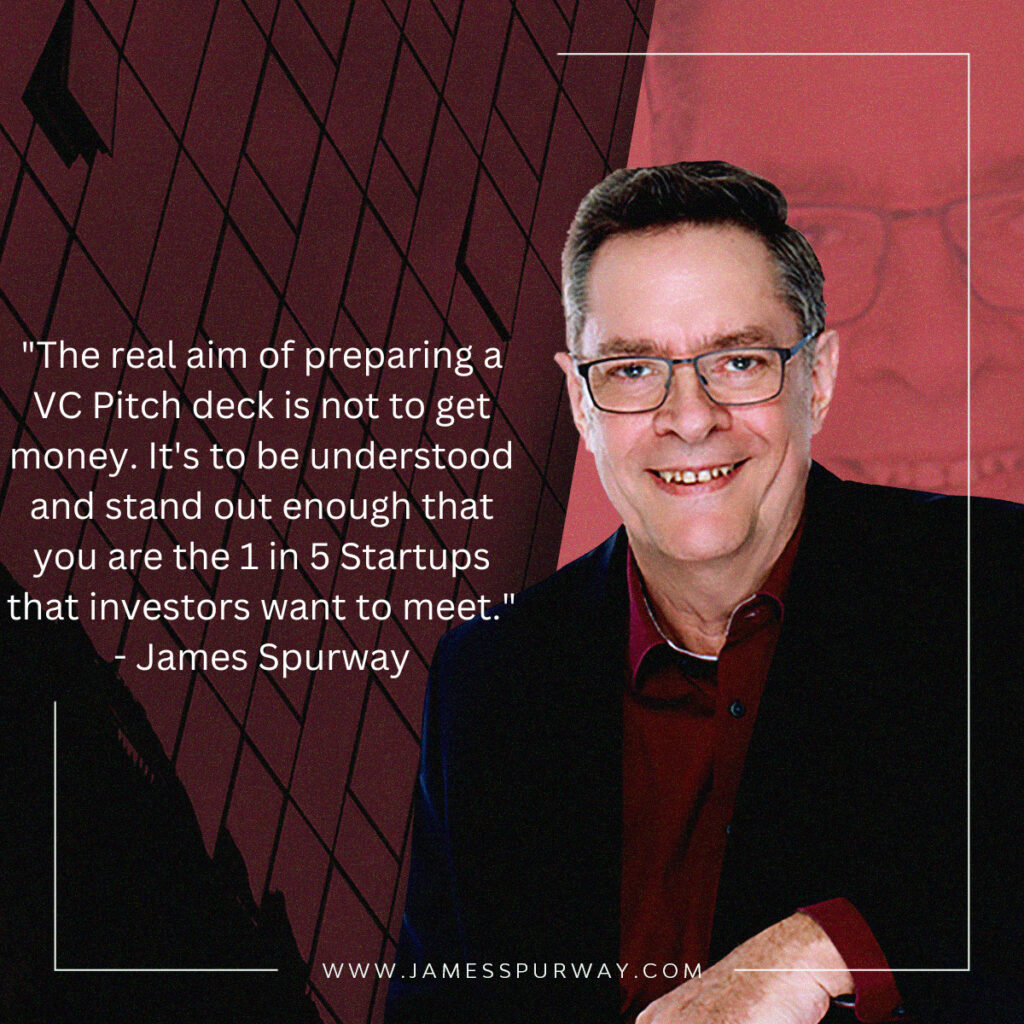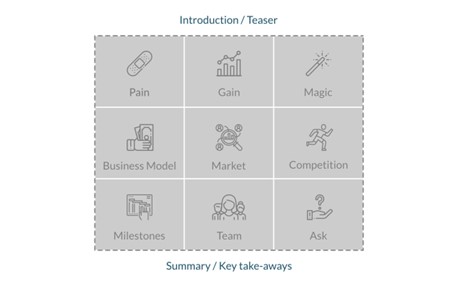How To Write A VC Pitch Deck That Investors Will Love
What I mean by a VC PITCH DECK is one that is up to the standard that a VC investor would expect to receive. Even if you are not yet raising external capital, or raising a small round for friends, family and angel investors, it pays to do the work now and get your deck up to scratch.
What's The Aim Of A VC Pitch Deck?

You might read my quote above and think – huh! It gets worse, however. If a VC was introduced to 1,000 companies a year, they might agree to meet with 200 (1 in 5) and invest in 2-4. That’s 1%-2% of the Startups they meet, but only a quarter to a half of one percent of all the startups who approached them. Hence the need to focus on writing a VC Pitch Deck.
What's The Main Message Of A VC Pitch Deck?
- You’ve identified (and, to whatever extent possible, proven) a viable business opportunity;
- The additional capital will let you pursue a strategy to access that business opportunity in a way that will produce a significant return on the investment;
- You and your team are capable of executing the strategy you’ve identified.
The Anatomy Of A VC Pitch Deck
First-time startup teams, as well as seasoned entrepreneurs, ask themselves which information to include in their pitch presentation. Many of them are looking for a checklist of must-have content. Unfortunately, there is no one-list-fits-all approach. Therefore, a checklist of the ten most relevant elements for pitch presentations would most likely lead to sub-par results.
Having had the privilege to witness hundreds of pitch presentations, coach dozens of teams, and discuss the matter with a diverse set of investors and several colleague presentation coaches or “pitch doctors,” I have created a matrix that our team regularly uses in supporting entrepreneurs today. This is a proven VC Pitch Deck format.
By reading this blog, you’re now the recipient of that IP that has taken me around 12 years to accumulate!
You may wish to save time and wasted effort trying to improve your VC Pitch Deck by instead using my Pitch Deck Review or have me review your entire documentation from an “Investor Readiness” by using this bundled product.
The Objective Of A VC Pitch Deck Presentation
Let’s talk about what happens when you follow advice and create a VC Pitch Deck and as a result, you get invited to an investor meeting.
TV shows like Dragons’ Den and its numerous international adaptations have been a blessing in raising awareness about startups and venture capital backing. But never forget that those shows are produced and cut for entertainment. The impression that – following a brief presentation and a couple of questions – an investor would stand up and immediately commit to a six or seven-figure investment is far from reality. Therefore, the overall objective of your pitch isn’t to convince a group of investors on the spot but to get them curious and eager to talk to you after your presentation.
While this might seem like an insignificant difference at first, there are some major implications: Pitching is not like an exam, where you would have to aim for completeness. Instead, you could compare pitching to dating! Who wouldn’t use the first date to stress his or her most attractive features instead of presenting a complete CV?
Pain, Gain & Magic!
The very first objective of your VC Pitch Deck pitch presentation should be to convince your audience of the overall relevance of your endeavour. Why do you do what you are about to present and why should anyone care? Therefore, the first elements you need to address are what we call pain, gain, and magic.

Start by addressing the problem you have chosen to solve: What is the pain your potential customers are facing? This could be as easy as describing the symptoms of an illness you are trying to cure or as tricky as illustrating the inefficiencies of an obscure market you would like to disrupt. Anyway, it has proven beneficial to make this pain as tangible as possible. Talk about individuals, not statistics. Focus on the most significant aspects instead of striving for completeness. Have your audience feel the pain of your target group.
Continue by describing the benefits of the solution you’re working on: What is the gain your customers can expect when buying and using your product or service? To what extent are you solving the problem? Are we talking about a sustainable solution or merely a band-aid? Make sure your audience understands the fit of the problem described and the answer provided by your offer.
The next part is often underestimated: But if the pain you have been describing is real and the gain you can generate is substantial, how come no one has thought of it before? The magic – or sometimes called the secret ingredient – is where you make transparent, what your main competitive advantage will be. If your team has invented a new technology or has exclusive access to it, now is the right time to say so.
Your presentation of pain, gain, and magic needs to be clear, fitting, and convincing. If you have trouble, clearly stating your customers’ challenges and your product’s or service’s benefits, you should probably take a step back and use tools like the Value Proposition Canvas to strengthen your pitch presentation.
Business Model, Market and Competition
You’ve tackled the problem and solution and added the secret ingredient. Great! – But how can you monetize it? The next component of the VC Pitch Deck, the second row of our matrix is all about your activities in the marketplace: Describe your business model, the market you’re addressing as well as your competition.

Talking about your business model can be real quick: Do you intend to sell apps for cell phones via well-known app stores? Enough said. Things can be considerably more complicated if you are facing a three-sided market or need to explain a business model which is atypical for your industry. Try and keep it as simple as possible, though.
In addition to understanding how you intend to make money; investors will need to know that you are aware of the characteristics of your market. What is the current market volume, which growth rate are you expecting and what do you consider as market potential? Who are the major players in your market and how is power distributed between current actors? This is also the right time to discuss special regulatory restrictions – if they are relevant to your activities. Prove to your audience that you understand the market you’re entering.
And of course, this includes presenting some insights into your competition. Even if your product or service is very new, please do not boast that you have no competition. If there is no competition, there typically is no real pain or problem. If you really can’t think of anyone, have a good look at your customers. How are they coping with the problem now? Perhaps they are your competition?
Milestones, Team and "The Ask"
The remaining part of your presentation should focus on your current activities. What is your current plan and which milestones are you working on? Who is on your team? What kind of money are you looking for (your “ask“) currently?

Your milestone planning should offer some details about your past achievements as well as insights into your future. How did you start? When did you acquire your first customers? Which growth rate are you expecting? – This part needs to fit the current phase of your startup. If you are a life science startup, you would probably want to talk about proof of mechanism, proof of principle, and proof of concept. If you could interact with customers at an early stage, talk about pilot projects. It might also be useful to speak of exit options. Please refrain, however, from getting too detailed at this point.
When presenting your team, you’ll have to answer the question of whether you have assembled a group of experts capable of the tasks ahead. It might be a good idea to highlight responsibilities and past experiences. If you are at an early stage, you might want to emphasize a missing competence which you’re trying to recruit a co-founder or key employee for.
Last but not least, never forget to state your ask. How much money do you need and what are you planning to spend it on? How long will this financing round keep you liquid and how will you use this time to reach a substantially higher company value to enable the next funding round? Despite what you might see on TV, it’s a bad idea to state the stake of the company which you are willing to give away. You might say “I am looking for 500,000 Euros in exchange for 20 % of the company,” but your investor audience will hear “I believe the valuation of my company to be 2.5 million Euros.” With the objective of your presentation being to initiate contact and feed curiosity, you should typically avoid the very controversial subject of company valuation until you’ve had a more in-depth conversation about what makes your startup special.
Introduction and Summary
So far, I have talked a lot about what should be in your VC Pitch Deck presentation. Now let me focus on two elements that you should neglect: A dull start and a banal end. Studies teach us that attention is highest at the beginning and at the end of a presentation. Please don’t waste those precious moments with sentences like “Good afternoon, ladies and gentlemen, and thank you for your interest in my pitch presentation. My name is Peter, and I’m the co-founder and CEO of Peter’s Startup Company,” or a final slide stating “Thank you very much for your attention.”

For the beginning, I would suggest stating the activities of your startup in one or two sentences. Maybe a phrase like “We are the [similar company in another industry] of [your industry].” This introduction might not be very original, but it has a considerable advantage: If you choose this analogy wisely, your audience will instantly get the gist of your activities. Even if you lose their attention at a later stage of your presentation, this will help them to catch up with what you are presenting. More advanced speakers might be more confident in their rhetorical skills and might neglect this little helper in favour of a more impressive introduction about the pain (see above). Feel free to introduce yourself at any later stage.
The "Golden Circle"
Now it’s up to you! There is a good reason why I have presented you with a matrix instead of an ordered list: The difference between an average pitch and an excellent pitch is your choice on how to empathize with or neglect the parts which are most important for your startup. Before doing that, you should be familiar with the inner logic of the matrix. It follows the golden circle approach.

The first row (i.e., pain, gain, and magic) contains elements that are most likely useful for describing why you’re doing what you are doing. Especially the pain or problem which you are tackling is typically a good starting point to make people care. Gain and magic are also essential answers to the question “why?”.
The second row (i.e., business model, market, and competition) answers the question “how?”. The contents of this row are like an outline of the rules of a game. The third row (i.e., milestones, team, and ask) discusses your actual moves – or “what” you are doing.
This breakdown is not the ONLY order that a pitch MUST follow, but it has been proven to work. Your magic, for example, could well include some details about what you are doing. But the main message from the magic element should be why you are doing what you are doing now.
Consequently, you should think twice before moving one specific element to another row. Still, there might be good reasons to do so. Let me give you an example: One question which I hear often is whether the introduction of the team shouldn’t be in the first third of the presentation.
The answer is rather simple: How important is your team to convince an investor to engage in your startup? Don’t get me wrong – no one will invest in your startup if you can’t present an impressive and competent team. But might your team even be the most important reason for an interest in your startup? Even more important (to the investor) than the actual problem that you are solving? Typically, this might be the case when you have gathered a group of successful serial entrepreneurs. Depending on your combined track record an investor might indeed think: “I don’t care what they are doing. They have proven to be effective in creating valuable businesses. So probably I want to be part of it.” – In that case, you might even consider starting with your team. Don’t forget, the primary objective of your pitch presentation is to attract the interest of your audience together with an urge to get in contact with you.
About the Author
James Spurway is an Angel Investor, Mentor, Advisor, Speaker, former Commercial Pilot, and Author who specialises in raising debt and equity capital.
He strives to model diversity, equity, and inclusion in the founders he agrees to invest and work with.
He has paused his angel investing activity to focus on raising his first US$ 50M venture capital fund, which will invest in startups that can accelerate the achievement of net zero emissions.
James spent the past 33 years living in Hong Kong, Vietnam, Germany, Switzerland, Monaco, the USA, Thailand, the Philippines, Singapore, and Australia, his country of birth.
In that time, he started 10 businesses, exited from seven, shut down two, and kept one.
He has invested in a total of 50 startups since 1993. In the period from 2003 until 2020, he had two successful exits from Unicorn startups. His average ROI sits at around 5X to date.
